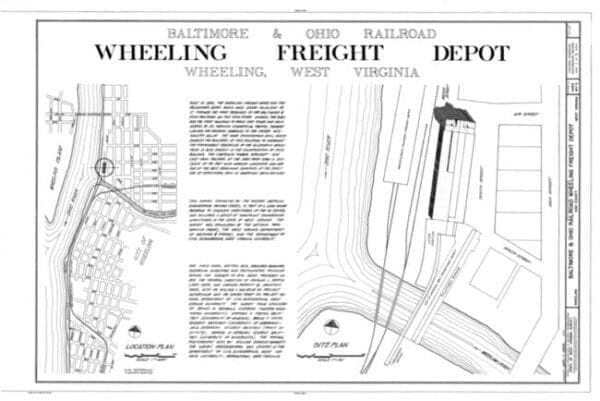On January 1, 1853, the first train arrived in Wheeling, West Virginia, (then Virginia) on the newly completed Baltimore & Ohio Railroad, the first rail line linking the Atlantic seaboard with the Ohio River.
The event was groundbreaking—not only for what would become northern West Virginia, but for the nation. For more than a quarter century, investors in Baltimore had battled to complete the route in an effort to rescue the city’s stagnating economy. The Appalachian barrier and the infancy of railroad engineering itself had delayed construction, which rivaled in importance that of New York’s east-west Erie Canal.
The line secured Baltimore’s situation as the largest metropolis south of Philadelphia and injected unimagined commerce into rural communities across what would become northern West Virginia.
Established towns along the line flourished, and farmsteads blossomed into trade centers. From east to west, Harpers Ferry, Martinsburg, Keyser, Piedmont, Terra Alta, Tunnelton, Rowlesburg, Grafton, Fairmont, Mannington, Farmington, Hundred, Littleton, Cameron, Moundsville, Glen Dale, McMechen, and Benwood all feature high-style architecture inspired by rail commerce rather than folk architecture more common in the Appalachians.
The spike that closed the line had been driven in at 6:05 p.m. on Christmas Eve at “Rosby’s Rock” on Grave Creek some 20 miles south of Wheeling, after which Roseberry Carr, superintendent of the line west of Cumberland, Md., gave the following speech, according to the Wheeling Intelligencer:
“We have now laid the last bar of the long link of railroad which connects the Chesapeake Bay and the waters of the Ohio, and I call upon all to give three hearty cheers for our president, Thomas Swan, and three more for our chief engineer, Benjamin H. Latrobe. May they both live to make many more connections of the western waters and the seaboard.’

“The cheers were most heartily given by the large united parties of tracklayers, and then the hills once more resounded to ‘three more for Roseberry Carr, Sr.’ This done, the men, tired with a hard day’s service, retired to their camp.”
The lion’s share of pomp and circumstance was reserved for the day of the arrival of the first train at Wheeling, attended by thousands of spectators, according to the Intelligencer:
“Yesterday morning dawned upon thousands who had come by steamboats, by coaches, on horses and on foot, from near and far, to participate in the commemoration of one of the greatest works of the age — the completion of an unbroken link connecting the Chesapeake with the waters of the Ohio.
“At an early hour the streets were thronged with a multitude of all ages, sexes and conditions, which was increased by the successive arrivals of various steamers crowded with passengers. Among them we noticed the steamer Wm Knox, with a large number of the citizens of Marietta, and the American Star, with a handsomely uniformed company, the ‘Steubenville Grays,’ commanded by Capt. Webster. This company and the Bridgeport Artillery, commanded by Capt. Grubb, presented an imposing appearance in our streets.
“By noon a dense crowd was assembled along the line of the track in Centre Wheeling, as far as the eye could see, awaiting the arrivals of the cars.
“At 2 o’clock the military, and the First Ward Hose and the Hope Fire Companies, formed into line and were conducted by the Marshals to the line of the track on the south side of the creek [Wheeling Creek]. In the morning a dispatch was received, announcing that the cars had reached Cumberland in the night and might be expected here at 3 or 4 o’clock, which they would undoubtedly have done had not a slight accident, news of which was received last night by the arrival of the mail train, caused a delay of several hours. It was the breaking of an axle-tree of the locomotive, which caused the detention, but no injury to any of the passengers.
“Last night the Suspension Bridge was brilliantly illuminated along its entire length with 1,010 lights, and its long curve of radiance stretching in mid-air against the ‘dark vaulted heavens,’ looked really like a triumphal rainbow spanning the storms which have beat in vain against its majestic form.”
At 8:30 p.m., the mail train arrived with about 50 passengers, mostly from Baltimore, according to the newspaper, and at 2:05 a.m., the first train of passenger cars arrived, “and several hundred of the citizens of Baltimore have been conducted to the McLure House, led by Capt. Holland’s Band of Independent Blues, whose soul-stirring music peals out upon the morning air, which wafts back a heart-felt welcome from all our citizens. The formal reception of the President and Directors of the Road, and the City’s guests, will take place at the Court House to-day at 11 o’clock.”
The last passenger train made its final run on the line into Wheeling on October 26, 1957, and, after final freight runs, the line was abandoned in 1973, and the removal of tracks and bridges commenced in 1974.
Parts of the B&O network today have been converted into rail trails.
The author of this article David Sibray, is the publisher of West Virginia Explorer Magazine. David travels the Mountain State to collect as many tales he can.

